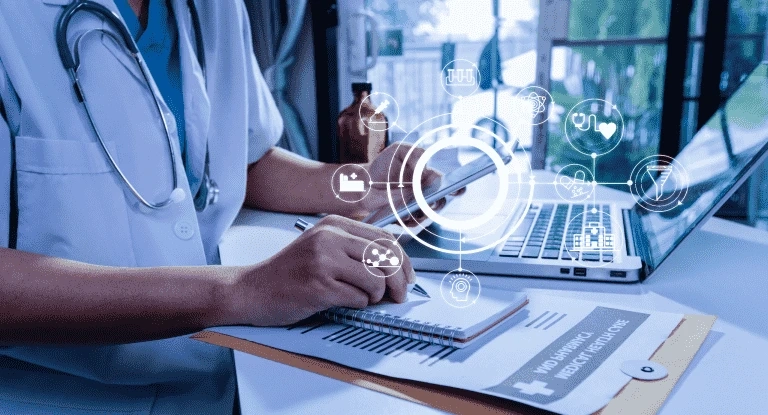The transition from traditional paper-based healthcare practices to electronic media started quite some time ago. By 2020, most US hospitals and office-based physicians were using electronic health record systems to manage patient health data. Despite such a digital transformation spree in the healthcare domain, achieving interoperability in health tech is a significant challenge. The presence of numerous technical, collaborative, and regulatory barriers in medical device software development prevents interoperability.
If you are a healthcare provider looking to boost interoperability in your healthcare system, this is the article for you! We will take you through the challenges of interoperability implementation in medical device software development and provide strategies for overcoming the challenges.
Let’s begin!
What is Interoperability in Healthcare?
Interoperability in healthcare means improving the exchange and integration of healthcare data across various systems to improve collaboration among stakeholders. Such interoperability makes access to patient data better and helps to boost the overall quality of care provided to patients.
Benefits of Interoperability in Healthcare
The core aim of healthcare interoperability is to improve patient outcomes and the overall efficiency of the healthcare ecosystem. Some of the key benefits of interoperability in medical device software development are:
With interoperability at work, patient care gets an instant upgrade. It is because patient health data is seamlessly shared among healthcare systems that helps in making better-informed clinical decisions. Seamless access to patient records reduces the chances of errors or redundancies in diagnosis and treatment. This contributes to the enhancement of overall care accuracy. Clinical processes get empowered with efficient data exchange as it helps to reduce paperwork and administrative burdens. This helps get rid of redundant processes of duplicating patient information! Interoperability also helps to empower patients. Every patient has instant access to their health records which promotes transparency and shared decision making.Challenges and Barriers to Achieving Interoperability
When you start working to establish interoperability in healthcare information technology, a complex range of challenges do come up. You need to have a deeper understanding of medical device software development to counter these challenges effectively. Some of the challenges are:
Data Silos and Fragmentation
In the healthcare system, the information is spread across disparate systems, which often leads to data silos obstructing data exchange. This creates confusion in terms of delayed care, lack of understanding in terms of patient history, and more! This can be made more efficient with the implementation of a unified interoperability platform that works to integrate diverse systems. All of it fosters a cohesive patient data environment that helps to boost the care quality.
Lack of Standardization
The healthcare data is present in various formats across the different HIT systems. This leads to compatibility issues, compromised data integrity, and data misinterpretation. It is high time to shift to industry standards such as FHIR, HL7, and IHE to foster a standardization process in healthcare data.
Privacy and Security
Another significant challenge in maintaining a balance between data accessibility, privacy, and security. When standard security measures are not followed, it leads to security breaches that pose a major threat. It is essential to stick with robust encryption of healthcare data, control access, and comply with privacy regulations to secure the foundation of healthcare data for achieving interoperability.
Resistance to Change
The most prominent issue that slows the adoption of interoperability solutions is resistance from stakeholders. This is why it is important to plan proper training programs to inform people about the benefits of interoperability. This way, stakeholders will gain more confidence because they are made to take part in the decision-making process.
Key Healthcare Interoperability Standards
Interoperability in medical device software development and healthcare rests majorly on the standardization process and frameworks used. The set standards work as the common language to foster communication and collaboration in the healthcare ecosystem.
HL 7
HL7 standard set by HL7 or Health Level Seven International, Inc works as the foundation to boost interoperability in healthcare. This helps to create a common language for sharing electronic health information, hence, fostering effective communication between systems. This streamlines patient data and provides a comprehensive view of the same.
Fast Healthcare Interoperability Resource
The previous healthcare standards had certain shortfalls and limitations, which are aptly addressed by FHIR from HL7. It is regarded as an interoperability standard that fosters granular data exchange, real-time interaction, and pushes the development of health tech solutions that can be easily integrated with existing systems.
Clinical Document Architecture
Clinical Document Architecture or CDA by HL7 specifically mentions certain structures and semantics of documents containing patient health information. With this, medical device software development becomes easier as it fosters the creation of human-readable documents. Such documents help in clinical information exchange between varying healthcare systems.
Digital Imaging and Communication in Medicine
The National Electrical Manufacturers Association came up with DICOM, a standard for passing, storing, and managing medical images. This majorly fosters interoperability in medical imaging by ensuring that all crucial medical images and relevant information can be easily transmitted and interpreted.
Technical Strategies for Enhancing Interoperability in Medical Device Software Development
Before taking up the task of ensuring interoperability in HIT systems, it is essential to understand the complex environment and tech regulations in place. Some of the pro-tips from
Leading medical software development companies are:
Use standardized protocols, such as HL7 and FHIR, to boost the efficient exchange of healthcare data across different systems. Ask your partner software development company in US to rapidly develop and deploy APIs that follow the industry standards to boost interoperability. Well-made APIs make it easier to communicate and share data between different software applications. Make use of cloud-based infrastructure to access and share health data securely and at large scale. Cloud-based solutions enable diverse platforms to access essential patient health information anytime, anywhere. Add systems that work on the idea of real-time exchange. Such real-time exchange of health data always offers timely and actionable insights for both the patient and the healthcare provider.Utilize unified data models that offer a standardized framework for all systems. This completely removes the need for time-consuming data mapping and translation. Also, the risk of errors and discrepancies due to varying data sources is totally mitigated with this.Conclusion
The healthcare industry is evolving at a rapid pace which is why it is crucial to ensure interoperability in the entire system. With digitization, all the data is online; however, it is of no use if the data cannot be interpreted by other platforms. In medical device software development, achieving interoperability should be the biggest goal. Only an interoperable system can ultimately help boost the quality of patient care. Discuss with your partner custom software development company how they plan to foster interoperability in the system. When you kickstart the medical device software development project, inform the partner software development company in US about your specific requirements!


